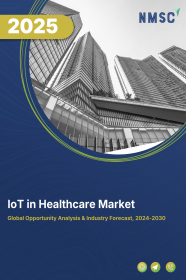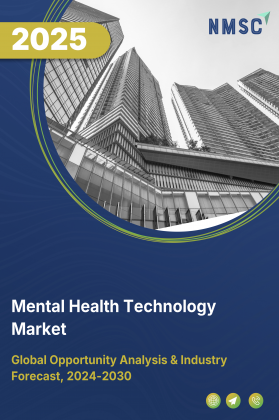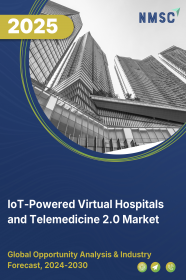
IoT in Healthcare Market by Component (Medical Device, Connectivity Solutions, Systems & Software, and Services), by Connectivity Technology (Cellular, Wi-Fi, Near Field Communications, Satellite, Bluetooth, Zigbee, and Others), by Application (Telemedicine, Clinical Operations, Workflow Management, and Others), and by End-User (Clinical Research Organizations, Research & Diagnostic Laboratories, and Others)- Global Opportunity Analysis and Industry Forecast 2024-2030.
IoT in Healthcare Market Report - Comprehensive Overview | |
| Study Period | 2020 - 2030 |
| Base Year for Estimation | 2024 |
| Forecast Data Period | 2026 - 2030 |
| Market Size in Base Year | 180.08 |
| Market Size in Forecast Year | 370.59 |
| Growth Rate 2026 - 2030 | 15.53% |
| Growth Factors | |
| Report Coverage | The report provides insights on market size, forecasts, emerging trends, competitive landscape, key segments, growth opportunities, recent developments, and strategic recommendations to help stakeholders make informed business decisions. |
| Segments Covered | IoT in Healthcare Market by Component (Medical Device, Connectivity Solutions, Systems & Software, and Services), by Connectivity Technology (Cellular, Wi-Fi, Near Field Communications, Satellite, Bluetooth, Zigbee, and Others), by Application (Telemedicine, Clinical Operations, Workflow Management, and Others), and by End-User (Clinical Research Organizations, Research & Diagnostic Laboratories, and Others) |
| Countries Covered | 28 |
| Geographical Analysis | North America (The U.S., Canada, Mexico); Europe (The UK, Germany, France, Italy, Spain, Denmark, Netherlands, Finland, Sweden, Norway, Russia, Rest of Europe); Asia-Pacific (China, Japan, India, South Korea, Australia, Indonesia, Singapore, Taiwan, Thailand, Rest of Asia-Pacific) and RoW (Latin America, Middle East, Africa) |
| Companies Profiled | Top 10 companies |
| Competitive Landscape | |
| Market Share | Available for top 10 companies |
| Customization Scope | Free customization (equivalent to up to 80 working hours of analysts) after purchase. Addition or alteration to country, regional, and segment scope. |
| Purchase Option | Avail customized purchase options to meet your exact research needs. |
Market Definition:
The IoT in Healthcare Market size was valued at USD 103.88 billion in 2023 and is predicted to reach USD 370.59 billion by 2030 with a CAGR of 19.90% from 2024-2030.
Internet of Things (IoT) in healthcare refers to the devices that enable remote healthcare monitoring, delivering safety & wellness to patient while empowering physicians to deliver superior care. Using IoT solutions and connected medical devices allows doctor to use real-time data to remotely monitor patients. This results in swift treatment and provides benefits such as continuous communication, reduces hospital resources and transportation costs. It also improves patient engagement and satisfaction as interactions with doctors become easier and more efficient. Data collected from IoT devices helps doctors to determine the best treatment process for their patients and achieve desired results.
Market Dynamics and Trends:
Growing adoption of Internet of things (IoT) in healthcare field that enables data collection, analysis and monitoring of electronic health records that contain personally identifiable information, protected health information, and other machine-generated healthcare data. It also offers important activities including improving patient outcomes and relieving the burden off medical professionals is driving the growth of IoT in healthcare market.
Also, the IoT solutions in hospitals enable efficient management of inventory, billing and medical records, medication compliance and hospital workflows. It improves the overall operational efficiency of the hospital services, which is expected to further propel the growth of IoT in healthcare market. Moreover, increasing demand for wearable devices that enables to track information related to health and wellnesses, location and provides real-time health monitoring data is further expected to drive the growth of IoT in healthcare market during the forecast period.
However, high risk of data breaches related to patients’ personal and health data along with sensitive data such as patient history, insurance information and payment transaction data are the factors restraining the growth of market during the forecast period. On the contrary, big data analytics is a growing area in IoT that uses technological advancements in machine learning, logical methods, computational intelligence and data mining. This facilitates the healthcare professionals such as payers and providers to get in depth knowledge & expertise which is expected to create ample growth opportunities for the IoT healthcare market in the coming years.
Market Segmentations and Scope of the Study:
The IoT in healthcare market share is segmented on the basis of components, connectivity technology, application, end user, and geography. On the basis of components, the market is divided into medical devices, connectivity solutions, systems & software, and services. The medical device is further sub divided into portable diagnostic devices and non-portable diagnostic devices. Systems & Software is sub-classified into remote device management, data analytics, network bandwidth management, network security, and application security. Services are sub-categorized into consulting, training, and education, support and maintenance services, system integration services. On the basis of connectivity technology, the market is classified into cellular, Wi-Fi, near field communications, satellite, Bluetooth, Zigbee, and others. On the basis of application, the market is categorized into telemedicine, clinical operations, workflow management, medication management, connected imaging, inpatient monitoring, and others. On the basis of end users, the market is bifurcated into clinical research organizations, research & diagnostic laboratories, hospitals & clinics, health insurance, and others. Geographic breakdown and analysis of each of the aforesaid segments include regions comprising North America, Europe, Asia-Pacific, and RoW.
Geographical Analysis:
North America holds the lion share of IoT in healthcare market at present and is expected to continue its dominance during the forecast period. This is attributed to increase in government investments to expand digital healthcare in this region. For instance, in August 2021, Biden-Harris administration announced investment of over USD 19 million by the Department of Health and Human Services (HHS) in the U.S in the healthcare sector. This investment helps to strengthen telehealth services in rural & undeserved communities and expand telehealth innovation and quality nationwide.
Also, presence of major key players such as IBM Corporation, Forescout Technologies, Cisco system Inc. and QUALCOMM that are adopting acquisition strategies that boosts the market growth in this region. For instance, in February 2022, Forescout Technologies acquired an early-stage healthcare security vendor, CyberMDX. This acquisition enables to monitor IT (Information Technology), IoT (Internet of Things), OT (Occupational Therapy) and IoMT (Internet of Medical Things) devices that help the company secure customer’s environment.
On the other hand, Asia-Pacific is expected to show a steady rise in the IoT in healthcare market due to the growing population that leads to increased adoption of wearable devices such as smartwatches, augmented reality glasses and fit bands owing to health concerns. Moreover, rising government initiative programs that promote eHealth and growing awareness in this region are expected to drive the IoT in healthcare market growth in this region. For instance, in February 2022, Indian government announced two new projects to promote digital health for their citizens. The two new projects include an open platform for its digital health mission and a national tele-mental health program that are going to be launched.
Competitive Landscape:
Various market players operating in the IoT in healthcare market includes Apple Inc., Cisco Systems Inc., GE Healthcare Ltd., Forescout Technologies, IBM Corporation, Medtronic PLC, Microsoft Corporation, Siemens Healthcare Private, Koninklijke Philips N.V. and QUALCOMM. These market players are launching various new products across various regions to maintain their dominance in the IoT in healthcare market.
For instance, in February 2022, Cisco announced to deliver 5G as-a-Service that offers healthcare enterprises to reduce technical, financial and operational risks with managing enterprise private 5G networks. 5G marks a milestone in wireless networking that creates new opportunities and digital infrastructure.
Also, in November 2021, GE Healthcare announced new AI-powered, automated and data-driven solutions. The new AI- powered and digital technologies include Allia Platform, AXM Navigate, SIGNA Hero and SIGNA Artist among others. This help to encourage greater diagnostic confidence, ease the burden of care and improve workflow for healthcare systems around the world.
Key Benefits:
-
The IoT in healthcare market report provides the quantitative analysis of the current market and estimations from 2022 to 2030. This analysis assists in identifying the prevailing market opportunities to capitalize on.
-
The study comprises of a detailed analysis of the IoT in healthcare market trends including the current and future trends for depicting the prevalent investment pockets in the market.
-
The information related to key drivers, restraints, and opportunities and their impact on the IoT in healthcare market is provided in the report.
-
The competitive analysis of the market players along with their market share in the IoT in healthcare market is mentioned.
-
The SWOT analysis and Porter’s Five Forces model are elaborated in the study.
-
The value chain analysis in the market study provides a clear picture of the stakeholders’ roles.
Key Market Segments:
By Component
-
Medical Device
-
Portable Diagnostic Devices
-
Non-Portable Diagnostic Devices
-
-
Connectivity Solutions
-
Systems & Software
-
Remote Device Management
-
Data Analytics
-
Network Bandwidth Management
-
Network Security
-
Application Security
-
-
Services
-
Consulting, Training, and Education
-
Support and Maintenance Services
-
System Integration Services
-
By Connectivity Technology
-
Cellular
-
Wi-Fi
-
Near Field Communications
-
Satellite
-
Bluetooth
-
Zigbee
-
Others
By Application
-
Telemedicine
-
Clinical Operations
-
Workflow Management
-
Medication Management
-
Connected Imaging
-
Inpatient Monitoring
-
Others
By End User
-
Clinical Research Organizations
-
Research & Diagnostic Laboratories
-
Hospitals & Clinics
-
Health Insurance
-
Others
By Geography
-
North America
-
U.S
-
Canada
-
Mexico
-
-
Europe
-
Germany
-
France
-
Italy
-
Spain
-
United Kingdom
-
Russia
-
Sweden
-
Rest of Europe
-
-
Asia-Pacific
-
Australia
-
China
-
India
-
Japan
-
South Korea
-
Indonesia
-
Singapore
-
Rest of Asia-Pacific
-
-
RoW
-
UAE
-
Brazil
-
South Africa
-
Israel
-
KSA (Kingdom of Saudi Arabia)
-
Turkey
-
Remaining Countries
-
Key Players
-
Apple Inc.
-
Cisco Systems Inc.
-
GE Healthcare Ltd.
-
Forescout Technologies
-
IBM Corporation
-
Medtronic PLC
-
Microsoft Corporation
-
Siemens Healthcare Private
-
Koninklijke Philips N.V.
-
QUALCOMM




















 Speak to Our Analyst
Speak to Our Analyst

























